
Introduction to Ear Mites in Cats
Ear mites, scientifically known as Otodectes cynotis, are a common parasitic infestation in cats that primarily lodges in the ears. They are microscopic, spider-like creatures that feed on the oils and wax in a cat’s ear canal. While they are not life-threatening, they can cause significant discomfort for felines and, if left untreated, lead to secondary infections or more severe ear conditions. Understanding how to identify, treat, and prevent ear mites is crucial for any cat owner aiming to maintain their pet’s overall health and hygiene.
Identifying Ear Mite Infestation
Before diving into cleaning tips, it is essential to recognize the signs of an ear mite infestation. Some common symptoms include:
– **Frequent Scratching:** Cats with ear mites often scratch their ears excessively due to the irritation caused by these parasites.
– **Head Shaking:** If your cat is shaking its head more than usual, it might be trying to dislodge the mites.
– **Dark Ear Discharge:** Ear mites can cause a black or brown waxy discharge, often resembling coffee grounds.
– **Inflammation and Redness:** The interior of the ear may appear red and inflamed due to scratching and irritation.
– **Odor:** A foul smell emanating from the ears can also indicate an infestation.
Recognizing these symptoms early can help in the prompt treatment of the condition, thereby minimizing discomfort for your cat.
Preparing for Ear Cleaning
Before starting the cleaning process, it is essential to prepare adequately to ensure both safety and effectiveness. Here are some steps to follow:
Gather Necessary Supplies
– **Ear Cleaning Solution:** Use a vet-approved ear cleaning solution specifically designed for cats. Avoid using hydrogen peroxide or alcohol, as these can irritate the sensitive ear canal.
– **Cotton Balls or Pads:** Cotton is gentle on the ears and effective in removing debris and discharge.
– **Towel:** Use a towel to wrap your cat securely, minimizing movement and potential scratches.
– **Treats:** Having some treats on hand can help reward and calm your cat during the process.
Creating a Calm Environment
Cats are sensitive creatures, and an ear cleaning session can be stressful. To ease the process:
– Choose a quiet, comfortable space where your cat feels safe.
– Speak in soothing tones to reassure your pet.
– Consider enlisting a helper to hold and comfort your cat if needed.
Step-by-Step Ear Cleaning Process
With everything set, you can begin the ear cleaning process. Follow these steps for an effective and safe cleaning:
Step 1: Secure Your Cat
Gently wrap your cat in a towel, leaving only the head exposed. This will help keep your cat still and prevent scratches.
Step 2: Inspect the Ears
Before cleaning, take a moment to inspect the inside of your cat’s ears. Look for signs of mites, wax buildup, or inflammation. If you notice severe redness, swelling, or wounds, it’s best to consult a veterinarian before proceeding.
Step 3: Apply the Ear Cleaning Solution
Hold the ear flap upright and carefully apply the ear cleaning solution as per the product’s instructions. Avoid inserting the nozzle too deeply into the ear canal.
Step 4: Massage the Ear
After applying the solution, gently massage the base of the ear for about 20-30 seconds. This helps to loosen the debris and wax, making it easier to remove.
Step 5: Remove Debris
Using a cotton ball or pad, gently wipe away the loosened debris and excess solution from the ear canal. Be careful not to push the cotton too deep into the ear to avoid damage.
Step 6: Repeat if Necessary
If the ears are particularly dirty or infested, you may need to repeat the process. Be gentle and patient, ensuring your cat is comfortable throughout.
Post-Cleaning Care
After cleaning, it’s essential to monitor your cat for any signs of discomfort or persistent symptoms.
Reward and Reassure
Offer your cat a treat and some affection to reinforce positive behavior and make future cleaning sessions easier.
Check for Continued Symptoms
Continue to observe your cat for any ongoing signs of ear mites. Persistent symptoms may require a visit to the vet for further examination and treatment.
Preventing Ear Mite Infestations
Prevention is always better than treatment. Here are some tips to prevent ear mite infestations in the future:
Regular Ear Checks
Incorporate regular ear inspections into your cat’s grooming routine. Early detection can prevent a minor issue from becoming a significant problem.
Maintain a Clean Environment
Keeping your cat’s living environment clean and free from other infested animals can reduce the risk of mites.
Use Preventative Treatments
Consult your veterinarian about preventative treatments for ear mites, especially if your cat is prone to infestations.
Regular Veterinary Check-Ups
Routine vet visits can help catch and address ear mites and other health issues early.
Conclusion
Ear mites, while common, do not have to be a persistent problem for your cat. By recognizing the signs, preparing correctly, and following a systematic cleaning process, you can effectively alleviate your cat’s discomfort and prevent future infestations. Remember, the key to a happy and healthy cat is regular grooming and prompt attention to any health issues that arise. With these essential ear mite cleaning tips, you can ensure your feline friend enjoys a comfortable and mite-free life.






